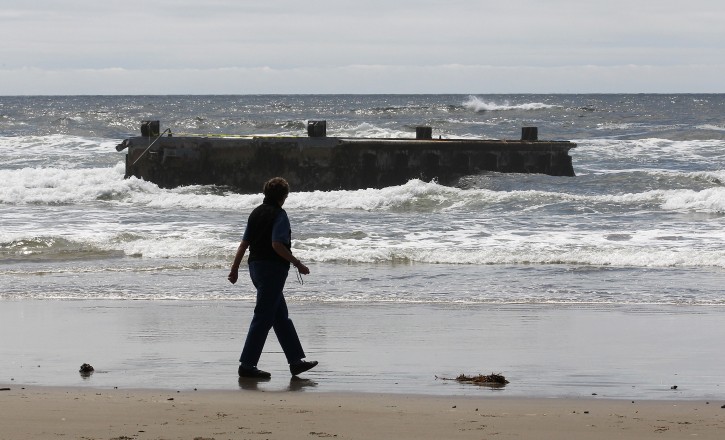 Newport, OR – A nearly 70-foot-long dock that floated ashore on an Oregon beach was torn loose from a fishing port in northern Japan by last year’s tsunami and drifted across thousands of miles of Pacific Ocean, a Japanese Consulate official said Wednesday.
Newport, OR – A nearly 70-foot-long dock that floated ashore on an Oregon beach was torn loose from a fishing port in northern Japan by last year’s tsunami and drifted across thousands of miles of Pacific Ocean, a Japanese Consulate official said Wednesday.
Subscribe to our Daily Roundup Email
A commemorative plaque on the dock showed it was one of four owned by Aomori Prefecture that broke loose from the port of Misawa on the northern tip of the main island, Deputy Consul Hirofumi Murabayashi said from Portland, Ore.
One of the four docks turned up several weeks later on an island south of Misawa, but the other two are still missing, said Akihisa Sato, an engineer with Zeniya Kaiyo Service, the dock’s Tokyo-based manufacturer.
The docks weigh 165 tons each, Sato said.
The one that floated to Oregon was first spotted floating offshore Monday, and mistaken by several people for a barge, said Chris Havel, spokesman for the Oregon Department of Parks and Recreation. It washed ashore early Tuesday on Agate Beach, a mile north of Newport on the central Oregon Coast. It’s made of concrete with a metal pontoon and measures 66 feet long, 19 feet wide and 7 feet high.
The distance between Japan and Oregon is roughly 5,000 miles.
A starfish native to Japan was among the marine life still clinging to the structure after the long voyage, Havel said.
“This is tsunami debris, not just from Japan, but from the tsunami itself,” Havel said.
John Chapman, a research scientist at Oregon State University’s Hatfield Marine Science Center, said hundreds of millions of other organisms also hitchhiked across the ocean on the dock — some of which are invasive species never before seen on this part of the West Coast.
Among the organisms are a species of tiny crab that has run wild on the East Coast but not on the West, and a kind of algae that has hit southern California but not Oregon, Chapman said.
“This is a very clear threat,” he said. “It’s exactly like saying you threw a bowling ball into a China shop. It’s going to break something. But will it be valuable or cheap glass. It’s incredibly difficult to predict what will happen next.”
A radiation check of the dock came up negative, which was to be expected if the dock broke loose before the nuclear power plant accident triggered by the waves, Havel said. The parks department was overseeing efforts to identify and remove the dock.
State police were posted to keep people from climbing on the dock, said Mitch Vance, shellfish program manager for the Oregon Department of Fish and Wildlife. Vance took samples of the mussels, barnacles and other shellfish clinging to the dock Wednesday morning. There also was green algae and brown kelp, he said.
Tom Cleveland, a housekeeping supervisor at some nearby beachfront condominiums, said the dock washed ashore in a storm, and people curious to see it have been jamming up traffic at a beach parking lot.
“Everybody and their brother has been here looking at it and checking it out,” Cleveland said. “Obviously, we knew things would be coming our way, but I didn’t expect anything this size.”
The Japanese coastal town of Misawa, where the dock originated, sustained extensive tsunami damage but is north of the most heavily hit areas in Iwate and Miyagi prefectures.
The four docks swept away from Misawa were installed four years ago, Sato said. They were used to transfer fish from fishing boats to trucks waiting to transport them to market.
Sato said the March 2011 tsunami also destroyed many buildings and structures around the port.
The bulk of the debris from the tsunami is not expected until winter, but fast-moving examples have been arriving on North America’s shores. They include a soccer ball that washed up in Alaska and a shipping container holding a Harley-Davidson motorcycle with Japanese license plates that turned up in British Columbia earlier this year.
Sen. Ron Wyden, D-Ore., called on the National Oceanic and Atmospheric Administration to redouble its efforts to track the debris, saying something as big as the dock could pose a danger to ships at sea.
Havel said the department would be responsible for removing the dock, which remained on the beach Wednesday morning. The plaque has been put in storage. It was not yet determined whether the dock would be towed off the beach and floated somewhere for disposal, or cut up on the beach for removal.
In the meantime, small crowds of people have been showing up on the beach to see the dock.
“I think that’s going to change to large crowds,” Havel said.

Finders keepers or hashovas aveidah?
Who is going to PAY to clean up this mess? USA or JAPAN!!
You’re going to need a Geiger counter to examine all the debris. Plutonium is not friendly stuff.